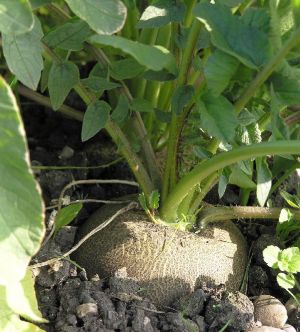Celery

Celery (Apium graveolens) is a marshland plant in the family Apiaceae that has been cultivated as a vegetable since antiquity. Celery has a long fibrous stalk tapering into leaves. Depending on location and cultivar, either its stalks, leaves or hypocotyl are eaten and used in cooking. Celery seed powder is used as a spice.
Celery is a biennial plant that is primarily grown for its thick stalk. It belongs to the Apiaceae family, which also includes parsley, carrots, and fennel. Celery leaves are pinnate to bipinnate, with rhombic leaflets 3-6 cm long and 2-4 cm wide. The flowers are creamy-white, 2-3 mm in diameter, and are produced in dense compound umbels. Modern cultivars have been selected for either solid petioles, leaf stalks, or a large hypocotyl. Wild celery, Apium graveolens var. graveolens, grows up to 1 meter tall and occurs around the globe.
The first cultivation of celery is believed to have happened in the Mediterranean region, where celery grew in agropyro-rumicion-plant communities. North of the Alps, wild celery is found only in the foothill zone on soils with some salt content. It prefers moist or wet, nutrient-rich, muddy soils.
Celery was first grown as a winter and early spring vegetable, and it was considered a cleansing tonic to counter the deficiencies of a winter diet based on salted meats without fresh vegetables. By the 19th century, the season for celery in England had been extended to last from the beginning of September to late in April.
The plants are raised from seed, sown either in a hot bed or in the open garden according to the season of the year, and, after one or two thinnings and transplantings, they are, on attaining a height of 15–20 cm, planted out in deep trenches for convenience of blanching, which is effected by earthing up to exclude light from the stems. Development of self-blanching varieties of celery, which do not need to be earthed up, dominate both the commercial and amateur market.
In North America, commercial production of celery is dominated by the cultivar called 'Pascal' celery. Gardeners can grow a range of cultivars, many of which differ from the wild species, mainly in having stouter leaf stems. They are ranged under two classes, white and red. The stalks grow in tight, straight, parallel bunches, and are typically marketed fresh that way. They are sold without roots and only a small amount of green leaf remaining.
In Europe, another popular variety is celeriac (also known as celery root), Apium graveolens var. rapaceum, grown because its hypocotyl forms a large bulb, white on the inside. The bulb can be kept for months in winter and mostly serves as a main ingredient in soup. It can also be shredded and used in salads. The leaves are used as seasoning; the small, fibrous stalks find only marginal use.()